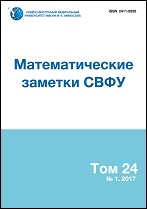|
Mathematics
Solution of the characteristic equation for some nonclassical diffusion model
V. A. Dubkoa, S. V. Zubareva, E. V. Karachanskayab
a Scientific and Training Center for Applied Informatics of the National Academy of Sciences of Ukraine, 40 Akademik Glushkov Avenue, Kyiv 03187, Ukraine
b Far Eastern State Transport University, 47 Seryshev Street, Khabarovsk 680021, Russia
Abstract:
An equation was constructed for the characteristic function $\psi(t,\lambda)=M[\exp(\lambda, x(t))/V=v(0)]$ of the position $x(t)$ of a Brownian particle for the Langevin model of the dynamics of a Brownian particle with perturbations orthogonal to its current velocity, in the regime when the particle velocity modulus becomes constant. Provided that the initial data $x(0)$, $v(0)$ are independent, a solution to the characteristic equation is found. The concept of the fundamental system of solutions of the equation for the characteristic function is formed employing the apparatus of the modified Bessel functions of the 1st kind. It was established that the solutions are decaying in time. The specific features of the behavior of solutions of the characteristic equation depending on the relation between the Stokes friction coefficient and the intensity of Wiener perturbations are considered under the condition that the modulus of the initial velocity of the particles is located on a manifold that is attractive for the velocity. In the presence of such relations, the spectrum of the function $\psi(t,\lambda)$ contains the domain of continuous values in the argument $\lambda$, where $\psi(t,\lambda)$ is an oscillatory process, as well as the domain with no oscillations. The obtained results confirm the conclusion that the model of the dynamics of a Brownian particle constructed on the basis of an unconventional physical interpretation for the Langevin equations, i.e., stochastic equations with orthogonal actions, leads to the interpretation of an ensemble of Brownian particles as a system with wave properties. These results are consistent with the previously obtained conclusions that under a certain agreement between coefficients in the original stochastic equation, under the condition that the values of random influences and friction are small, the Langevin equations lead to description of the probability density function for the position of the particle on the basis of wave equations. For large random influences and friction, the probability density function is a solution to the diffusion equation with a diffusion coefficient that is lower than in the classical diffusion model.
Keywords:
Langevin equation, ensemble of particles, diffusion, wave equation, characteristic function.
Received: 08.01.2021
Revised: 22.02.2021
Accepted: 26.02.2021
Citation:
V. A. Dubko, S. V. Zubarev, E. V. Karachanskaya, “Solution of the characteristic equation for some nonclassical diffusion model”, Mathematical notes of NEFU, 28:1 (2021), 12–26
Linking options:
https://www.mathnet.ru/eng/svfu307 https://www.mathnet.ru/eng/svfu/v28/i1/p12
|

| Statistics & downloads: |
| Abstract page: | 90 | | Full-text PDF : | 72 |
|




 Contact us:
Contact us: Terms of Use
Terms of Use
 Registration to the website
Registration to the website Logotypes
Logotypes








 Citation in format
Citation in format 